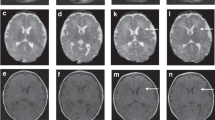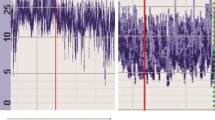Abstract
Objective
There is variation in the clinical practice for the use of cranial ultrasound (cUS) at the time of initiation of therapeutic hypothermia (TH) for neonatal encephalopathy. The role of cUS in selecting patients who may benefit from TH or excluding those where TH may impose risk is unknown.
Study design
A retrospective study was conducted on infants who received TH at a single tertiary center. Findings from cUS at initiation of TH were compared to findings from MRI following the completion of TH.
Results
One hundred and eight infants were studied. Of the 55 with abnormalities on early cUS, 50 did not have corresponding MRI abnormalities. In contrast, 16 infants had some degree of intracranial hemorrhage detected on their MRI that was not noted on earlier cUS.
Conclusions
This study challenges whether cUS is an essential universal screening tool prior to the commencement of TH.
This is a preview of subscription content, access via your institution
Access options
Subscribe to this journal
Receive 12 print issues and online access
$259.00 per year
only $21.58 per issue
Buy this article
- Purchase on Springer Link
- Instant access to full article PDF
Prices may be subject to local taxes which are calculated during checkout


Similar content being viewed by others
References
Groenendaal F, de Vries LS. Fifty years of brain imaging in neonatal encephalopathy following perinatal asphyxia. Pediatr Res. 2017;81:150–5.
Executive summary: Neonatal encephalopathy and neurologic outcome, second edition. Report of the American College of Obstetricians and Gynecologists’ Task Force on Neonatal Encephalopathy. Obstet Gynecol. 2014;123:896–901.
Salas J, Tekes A, Hwang M, Northington FJ, Huisman T. Head ultrasound in neonatal hypoxic-ischemic injury and its mimickers for clinicians: a review of the patterns of injury and the evolution of findings over time. Neonatology. 2018;114:185–97.
Annink KV, de Vries LS, Groenendaal F, Vijlbrief DC, Weeke LC, Roehr CC, et al. The development and validation of a cerebral ultrasound scoring system for infants with hypoxic-ischaemic encephalopathy. Pediatr Res. 2020;87:59–66.
Bednarek N, Mathur A, Inder T, Wilkinson J, Neil J, Shimony J. Impact of therapeutic hypothermia on MRI diffusion changes in neonatal encephalopathy. Neurology. 2012;78:1420–7.
Lally PJ, Montaldo P, Oliveira V, Soe A, Swamy R, Bassett P, et al. Magnetic resonance spectroscopy assessment of brain injury after moderate hypothermia in neonatal encephalopathy: a prospective multicentre cohort study. Lancet Neurol. 2019;18:35–45.
Shalak L, Perlman JM. Hypoxic-ischemic brain injury in the term infant-current concepts. Early Hum Dev. 2004;80:125–41.
Martinez-Biarge M, Diez-Sebastian J, Rutherford MA, Cowan FM. Outcomes after central grey matter injury in term perinatal hypoxic-ischaemic encephalopathy. Early Hum Dev. 2010;86:675–82.
Bonifacio SL, Glass HC, Vanderpluym J, Agrawal AT, Xu D, Barkovich AJ, et al. Perinatal events and early magnetic resonance imaging in therapeutic hypothermia. J Pediatr. 2011;158:360–5.
Trivedi SB, Vesoulis ZA, Rao R, Liao SM, Shimony JS, McKinstry RC, et al. A validated clinical MRI injury scoring system in neonatal hypoxic-ischemic encephalopathy. Pediatr Radiol. 2017;47:1491–9.
Weeke LC, Groenendaal F, Mudigonda K, Blennow M, Lequin MH, Meiners LC, et al. A novel magnetic resonance imaging score predicts neurodevelopmental outcome after perinatal asphyxia and therapeutic hypothermia. J Pediatr. 2018;192:e32.
Barkovich AJ, Hajnal BL, Vigneron D, Sola A, Partridge JC, Allen F, et al. Prediction of neuromotor outcome in perinatal asphyxia: Evaluation of MR scoring systems. Am J Neuroradiol. 1998;19:143–9.
Shankaran S, Barnes PD, Hintz SR, Laptook AR, Zaterka-Baxter KM, McDonald SA, et al. Brain injury following trial of hypothermia for neonatal hypoxic-ischaemic encephalopathy. Arch Dis Child Fetal Neonatal Ed. 2012;97:F398–404.
Shankaran S, Laptook AR, Tyson JE, Ehrenkranz RA, Bann CM, Das A, et al. Evolution of encephalopathy during whole body hypothermia for neonatal hypoxic-ischemic encephalopathy. J Pediatr. 2012;160:567–72.e563.
White YN, Grant PE, Soul JS, Inder T, El-Dib M. Early exit from neonatal therapeutic hypothermia: A single institution experience using MRI to guide decision-making. J Neonatal Perinatal Med. 2020;13:441–7.
Jacobs SE, Morley CJ, Inder TE, Stewart MJ, Smith KR, McNamara PJ, et al. Whole-body hypothermia for term and near-term newborns with hypoxic-ischemic encephalopathy: a randomized controlled trial. Arch Pediatr Adolesc Med. 2011;165:692–700.
Simbruner G, Mittal RA, Rohlmann F, Muche R. neo.nEURO.network Trial Participants. Systemic hypothermia after neonatal encephalopathy: outcomes of neo.nEURO.network RCT. Pediatrics. 2010;126:E771–8.
Gluckman PD, Wyatt JS, Azzopardi D, Ballard R, Edwards AD, Ferriero DM, et al. Selective head cooling with mild systemic hypothermia after neonatal encephalopathy: multicentre randomised trial. Lancet. 2005;365:663–70.
Zhou WH, Cheng GQ, Shao XM, Liu XZ, Shan RB, Zhuang DY, et al. Selective head cooling with mild systemic hypothermia after neonatal hypoxic-ischemic encephalopathy: a multicenter randomized controlled trial in China. J Pediatr. 2010;157:367–72.
Eicher DJ, Wagner CL, Katikaneni LP, Hulsey TC, Bass WT, Kaufman DA, et al. Moderate hypothermia in neonatal encephalopathy: safety outcomes. Pediatr Neurol. 2005;32:18–24.
Gorelik N, Faingold R, Daneman A, Epelman M. Intraventricular hemorrhage in term neonates with hypoxic-ischemic encephalopathy: a comparison study between neonates treated with and without hypothermia. Quant Imaging Med Surg. 2016;6:504–9.
Lakatos A, Kolossváry M, Szabó M, Jermendy Á, Barta H, Gyebnár G, et al. Neurodevelopmental effect of intracranial hemorrhage observed in hypoxic ischemic brain injury in hypothermia-treated asphyxiated neonates - an MRI study. BMC Pediatr. 2019;19:430.
Nelson MD Jr, Tavaré CJ, Petrus L, Kim P, Gilles FH. Changes in the size of the lateral ventricles in the normal-term newborn following vaginal delivery. Pediatr Radiol. 2003;33:831–5.
Salas J, Reddy N, Carson KA, Northington FJ, Huisman T. Ultrasound Predicts White Matter Integrity after Hypothermia Therapy in Neonatal Hypoxic-Ischemic Injury. J Neuroimaging. 2019;29:743–9.
Stark JE, Seibert JJ. Cerebral artery Doppler ultrasonography for prediction of outcome after perinatal asphyxia. J Ultrasound Med. 1994;13:595–600.
Archer LN, Levene MI, Evans DH. Cerebral artery Doppler ultrasonography for prediction of outcome after perinatal asphyxia. Lancet. 1986;2:1116–8.
Snyder EJ, Perin J, Chavez-Valdez R, Northington FJ, Lee JK, Tekes A. Head ultrasound resistive indices are associated with brain injury on diffusion tensor imaging magnetic resonance imaging in neonates with hypoxic-ischemic encephalopathy. J Comput Assist Tomogr. 2020;44:687–91.
Leijser LM, Vein AA, Liauw L, Strauss T, Veen S, Wezel-Meijler G. Prediction of short-term neurological outcome in full-term neonates with hypoxic-ischaemic encephalopathy based on combined use of electroencephalogram and neuro-imaging. Neuropediatrics. 2007;38:219–27.
Barnette AR, Horbar JD, Soll RF, Pfister RH, Nelson KB, Kenny MJ, et al. Neuroimaging in the evaluation of neonatal encephalopathy. Pediatrics. 2014;133:e1508–17.
Tann CJ, Nakakeeto M, Hagmann C, Webb EL, Nyombi N, Namiiro F, et al. Early cranial ultrasound findings among infants with neonatal encephalopathy in Uganda: an observational study. Pediatr Res. 2016;80:190–6.
Author information
Authors and Affiliations
Contributions
WS contributed to the conception of the work, data acquisition, and analysis. He drafted the paper, approved final version and agrees with all aspects of the work. ES, EY, TI, and ME contributed to the conception of the work. They revised the paper critically for important intellectual content, approved final version and agreed with all aspects of the work.
Corresponding author
Ethics declarations
Competing interests
The authors declare no competing interests.
Additional information
Publisher’s note Springer Nature remains neutral with regard to jurisdictional claims in published maps and institutional affiliations.
Rights and permissions
About this article
Cite this article
Sanislow, W., Singh, E., Yang, E. et al. Value of cranial ultrasound at initiation of therapeutic hypothermia for neonatal encephalopathy. J Perinatol 42, 335–340 (2022). https://doi.org/10.1038/s41372-021-01233-0
Received:
Revised:
Accepted:
Published:
Issue Date:
DOI: https://doi.org/10.1038/s41372-021-01233-0
This article is cited by
-
Magnetic resonance venography to evaluate cerebral sinovenous thrombosis in infants receiving therapeutic hypothermia
Pediatric Research (2023)
-
Comment on ‘value of cranial ultrasound at initiation of therapeutic hypothermia for neonatal encephalopathy’
Journal of Perinatology (2022)



